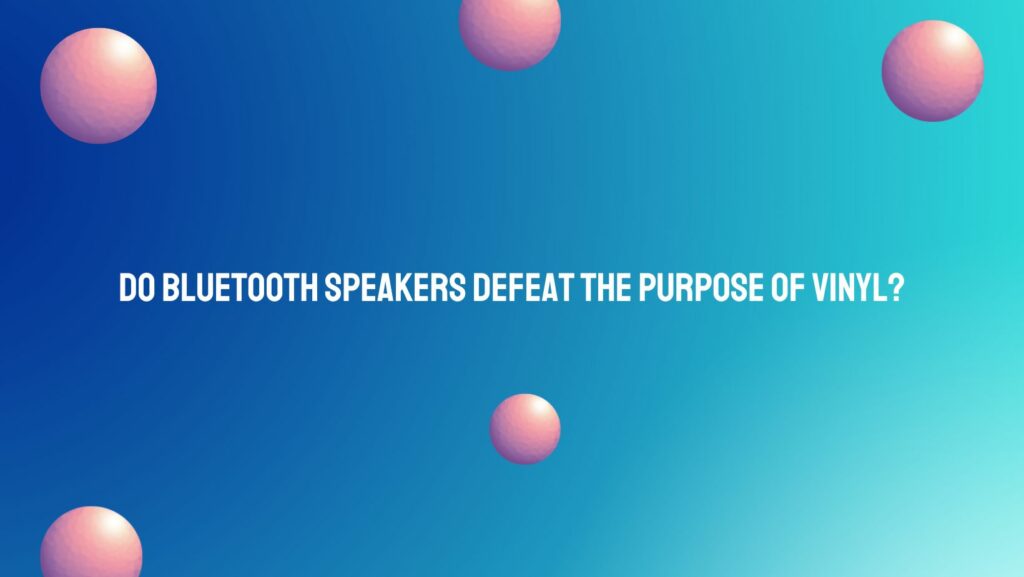The resurgence of vinyl in recent years has brought about a confluence of the analog and digital worlds, sparking debates about the ideal way to experience the rich sound of vinyl records. In this article, we explore the question: Do Bluetooth speakers defeat the purpose of vinyl? By delving into the characteristics of both mediums and considering the nuances of audio fidelity, we aim to shed light on the relationship between Bluetooth technology and the cherished analog experience of vinyl playback.
The Essence of Vinyl:
- Analog Warmth and Nuance: Vinyl records are celebrated for their analog warmth and nuanced sound reproduction. The process of engraving sound waves onto grooves creates a unique sonic texture that resonates with audiophiles and music enthusiasts seeking a more immersive and authentic listening experience.
- Intimacy with the Music: Vinyl playback invites a more intimate connection with the music—flipping through album covers, carefully placing the stylus on the record, and experiencing the album as a cohesive piece of art. The tangible and tactile nature of vinyl enhances the overall engagement with the music.
Bluetooth Technology in Audio:
- Wireless Convenience: Bluetooth technology offers the convenience of wireless audio transmission, allowing users to connect their devices seamlessly without the need for physical cables. This feature aligns with the modern emphasis on portability and ease of use.
- Compression and Sound Quality: One of the primary concerns with Bluetooth technology is the use of compression algorithms that may sacrifice audio quality. Traditional Bluetooth codecs, such as SBC (Subband Coding), may introduce perceptible losses in fidelity, potentially compromising the nuanced sound characteristic of vinyl.
The Intersection of Vinyl and Bluetooth:
- Convenience vs. Fidelity: Bluetooth speakers, while convenient, introduce a layer of wireless connectivity that may be perceived as conflicting with the audiophile pursuit of high-fidelity audio. The convenience of Bluetooth may come at the cost of sacrificing some of the intricacies and details cherished in the vinyl experience.
- Choosing High-Quality Codecs: The impact of Bluetooth on vinyl playback largely depends on the specific Bluetooth codec used. Audiophiles can mitigate some of the sound quality concerns by opting for turntables and speakers that support higher-quality codecs such as aptX, aptX HD, or LDAC, which offer better fidelity.
- Balancing Modern Convenience and Analog Purity: For some enthusiasts, the allure of vinyl lies in its purist form—analog sound delivered through a traditional audio chain. Bluetooth speakers, with their wireless convenience, can be seen as a departure from this purist ideal. However, others argue that the convenience of wireless connectivity enhances the accessibility and integration of vinyl into modern lifestyles.
Conclusion:
The debate over whether Bluetooth speakers defeat the purpose of vinyl is a nuanced exploration of the intersection between tradition and modernity in the realm of audio. While Bluetooth technology introduces a layer of convenience that may challenge the purist ideals of vinyl enthusiasts, advancements in codec technology and the versatility of Bluetooth-enabled devices offer opportunities for a harmonious coexistence.
Ultimately, the choice between wired and Bluetooth speakers for vinyl playback is a matter of personal preference. Whether you prioritize the ritualistic experience of vinyl or embrace the convenience of wireless connectivity, the joy of music remains at the heart of the listening experience. In navigating this dichotomy, audiophiles and music lovers alike can find a balance that resonates with their individual preferences and ensures the enduring magic of vinyl continues to captivate new generations of enthusiasts.


